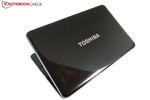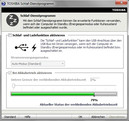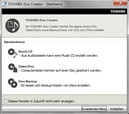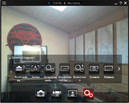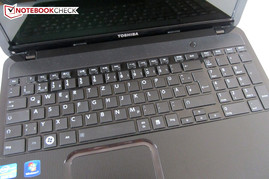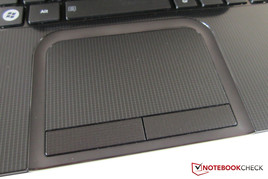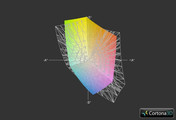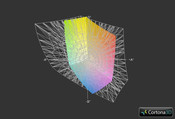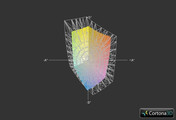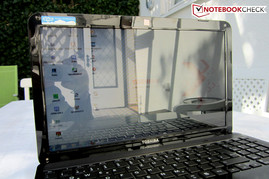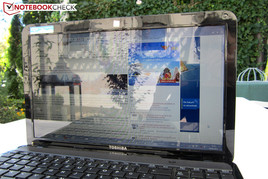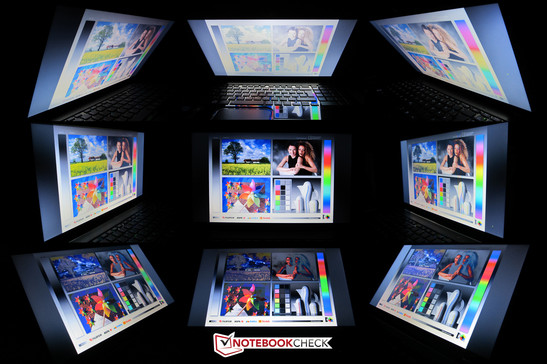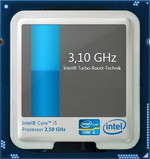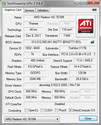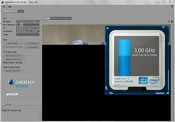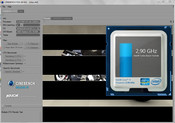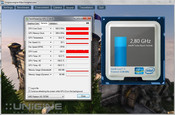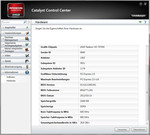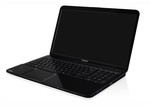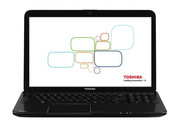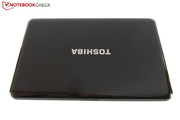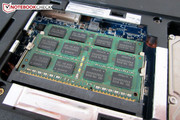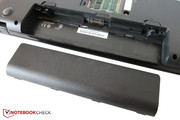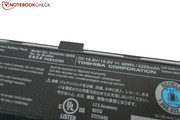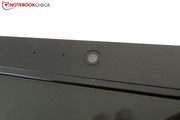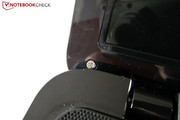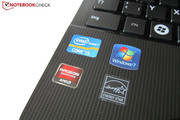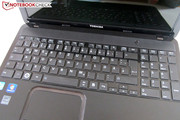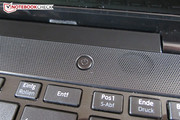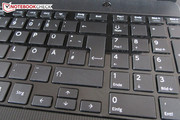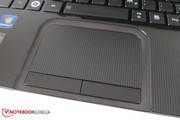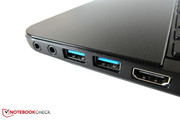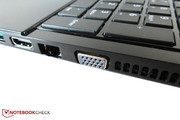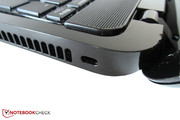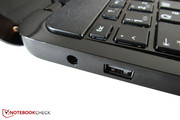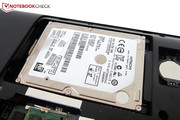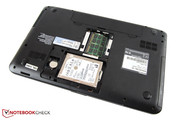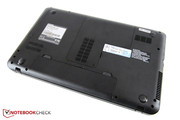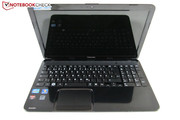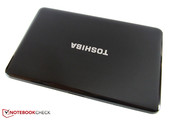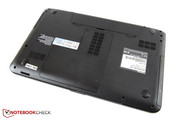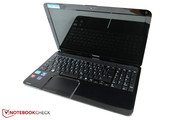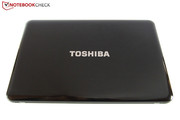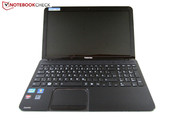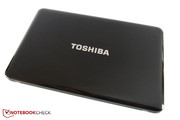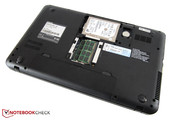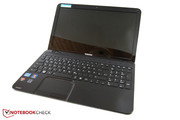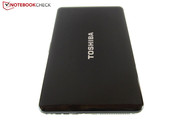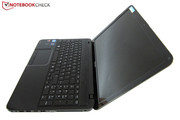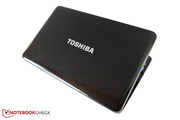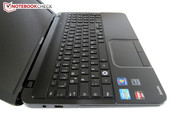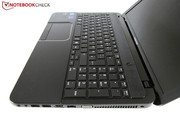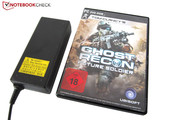Review Toshiba Satellite L850-153 Notebook
Toshiba does not make a purchase easy for its potential buyers. The homepage of the Japanese manufacturer is covered by various models and series, which can quickly overwhelm inexperienced laptop users. We have tested the L850 series and put together a comprehensive review for our readers.
The standard models without a "D" in the product name are definitely equipped with a modern Intel CPU. With the exception of the Satellite L850-139 (Core i5-2450M), all other models of the series have a dual- or quad-core processor from the Ivy Bridge generation (Core i5-3210M and Core i7-3610QM respectively). The DDR3 RAM ranges between 4 to 8 GB and the hard disk capacity lies between 500 to 1000 GB. The colors of the models differ (depending on the model), which means that the laptop can either be black, dark silver, white, red or blue.
The popular Windows 7 Home Premium (64 bit) serves as the operating system (OS) of our test model. The Radeon HD 7670M GPU we mentioned at the start, is based on the old Terascale 2 architecture, unlike the HD 7700 series which uses AMD's new GCN architecture (see Dell Inspiron 15R SE). As shown by our benchmarks, the performance of the HD 7670M is close to that of the Nvidia GPUs.
Back to our topic: the L850 series is joined by the L850D series. The main difference between the two is the CPU: instead of an Intel CPU, the models of the L850D series use the slower, dual-core AMD A6-4400M. For graphics, the models of the L850D employ either the Radeon HD 7520G integrated graphics processor (IGP) of the A6-4400M, or a combination of the HD 7520G and a dedicated Radeon HD 7610M GPU. The dual-graphics system suffers from a few early issues, and due to this we would not recommend the L850D series, despite the low price.
In addition, we have the Toshiba L855 and L855D series, which are slightly more expensive, and have an aluminum finish. The L855 series uses Sandy Bridge or Ivy Bridge processors with a HD 7670M, whereas the L855D series employs an A8-4500M with a HD 7640G. Buyers looking for a smaller or larger notebook, will be served well by the Toshiba Satellite L830 (13-inch) or L870/L875 (17-inch).
Case
We think the "matt black" description is a bit off as, except for the bottom and the keyboard, the 2.4 kg laptop is glossy and one of the most sensitive models on the market. Some of the surfaces have a nice line pattern, but sadly the case is a magnet for fingerprints and, due to the glossy black finish, scratches are not far off.
The workmanship is sub-optimal. Our test model has various projecting edges. In addition, a screwed flap came loose in the display border (see the picture gallery to the right). Even the cheapest multimedia notebooks should not have such serious flaws.
Furthermore, the 15-inch test model is not very sturdy. The keyboard and areas around the battery and optical drive are very susceptible to pressure. Additional flaws: the USB ports must be poorly designed as devices connected to them are lost and not recognized by the computer at even the slightest of collisions.
The monitor is quite wobbly, although the user requires both hands to open the laptop. We find the sensitive and unstable case of the Satellite L850 to be its biggest weakness. Most competitors are of better quality. Thankfully, Toshiba has made fewer mistakes in other areas.
Connectivity
Interfaces
The Japanese manufacturer provides the standard ports. The left side offers one USB 2.0 port (with Sleep-and-Charge function), the power in and the optical drive (Super Multi CD/DVD burner). On the right side, near the front, we have two sound jacks (headphones + microphone), two USB 3.0 ports, an HDMI interface and an RJ-45 Gigabit LAN port. The fan is also placed on the right and surrounded by a VGA interface and the Kensington Lock. The obligatory card reader is placed at the front.
This positioning of ports is not the best. If the user plugs in a lot of devices on the right side, he/she will frequently "trip" over cables. The smaller brother of this test model has a similar distribution of interfaces.
Wireless Communication
The Satellite L850 is equipped with Bluetooth 4.0 and WLAN 802.11 b/g/n. Our test model has an AR9485WB-EG network adapter from Qualcomm Atheros (2.4 GHz).
Maintenance
The upgrade possibilities are very limited. Once the flap on the bottom is removed, the user can access the hard drive and the RAM. 2 DDR3 RAM modules should suffice most users (max 16 GB).
As the graphics card is soldered onto the mainboard and the Toshiba test model operates on a dual- or quad-core CPU, we can somewhat accept this limited room for upgrades. However, the fact that the user cannot easily access and clean the fan is very annoying.
Software
Toshiba is infamous for loading a lot of software on its models. The Satellite L850 is not an exception. The first time it is turned on, the user will find around 60 more or less sensible programs and tools on the hard drive. For example, we have the Starter edition of Microsoft Office 2010 and Nero 11 Essentials. There are various bloatware programs and about 20 programs made by Toshiba themselves. This palette extends from "A" as in Toshiba Assist to "W' as in Web Camera Application (see screenshots).
In use, the system is slightly slowed down and has somewhat annoying pop-ups. Those users who prefer a clean system should de-install most programs after a while of use.
Packaging
The packaging is relatively meager in comparison to the software. We have a Lithium Ion battery (300 grams), a half-way compact 90 W power adapter (330 grams), a short intro, and a guarantee card in the box. The System Recovery partition can be found on the 500 GB HDD.
Guarantee
Toshiba offers an international Bring-in service which spans over 24 months for this test model. Those buyers, who register the repair directly over the notebook hotline, will get on-site service.
Input Devices
Keyboard
The non-lit chiclet keyboard (the Satellite L750/L755 had a more classical model) has not been designed well by the manufacturer. The list of negatives includes the flat cursor keys, the arbitrary layout (End and Print are both on the same key), and the spongy typing feel. The impact is quite vague. Most users will not be happy about the fact that the intelligently placed special functions can be used without pressing the Fn key simultaneously. This can be changed in the BIOS (press F2 while booting, Advanced, System Configuration, Function Keys mode).
There is little left to criticize. The keys measure 14.5 x 14.5 millimeters, which is very acceptable. The numeric pad is a nice extra. Note: in our test model, the Esc key snapped in an ugly fashion.
Touchpad
The touchpad is far better. Thanks to the recess and the roughened surface, the device guarantees great feedback. Despite the structuring, the sliding properties are not at all bad. As is standard for 2012, the touchpad can recognize multi-touch gestures. The supported gestures work well most of the time, with the exception of a few cases. We would characterize the precision as very good.
Great: due to the nice dimensions (96 x 56 mm), the user can cover large areas on the screen in a single motion (without moving his/her finger back). In our opinion, the two mouse keys could have had a much firmer pressure point.
Display
The 15.6-inch glare panel uses the standard 16:9 format. A resolution of 1366x768 pixels is not a guarantee of sufficient workspace, but will not overload the hardware when running games. According to our measurements, the AU Optronics B156XTN02.0 panel is an ordinary 08/15 product, as should be expected of this price category.
| |||||||||||||||||||||||||
Brightness Distribution: 96 %
Center on Battery: 219 cd/m²
Contrast: 168:1 (Black: 1.3 cd/m²)
53.4% AdobeRGB 1998 (Argyll 3D)
73% sRGB (Argyll 3D)
51.8% Display P3 (Argyll 3D)
Despite the promise of a "high brightness display", the average brightness lies at 220 cd/m² – a decent value, but not exceptional. The contrast is also lower than expected. Good 15-inch panels, like the LG Philips LP156WF1 (see Schenker XMG A502) manage a contrast higher than 500:1, whereas the Satellite L850 settles at less than 200:1.
The disappointing black value (~1.3 cd/m²) affects the dark scenes of videos and games. The number must be below 0.5 cd/m² for a satisfying black. The modest color coverage falls short of the expected level. The 15-inch test model has serious problems covering the sRGB color space, and that means it is far from covering the AdobeRGB color space. At least the colors are better than those found in the Satellite L830.
This multimedia laptop is not suited for outdoors use. The screen is plagued by massive reflections outdoors and the average brightness is not high enough to make it clearly legible. In fact, on bright days, recognizing anything on the screen can be nigh impossible. Users who like taking their laptop outdoors should take a look at other models with a matt screen or higher brightness (for example, the Asus N56VM).
The viewing angle stability is not great. As is typical of cheap TN panels, the colors invert quickly due to changes in the vertical viewing angle. Horizontal changes also affect the picture but far less than vertical changes, as long as the user is not seated at a skewed angle. The display of the Satellite L850 is far from ideal for an entertainment or multimedia notebook.
Performance
Processor
The Core i5-3210M is a dual-core CPU from Intel's Ivy Bridge generation, which can process up to 4 threads simultaneously thanks to Hyperthreading technology. Although the 3 MB L3 cache is smaller than that of the bigger, quad-core Core i7-3610QM (6 MB), the cache is well-sized. With the help of the Turbo Boost function, the dual-core can be overclocked from 2.5 GHz to a max 3.1 GHz at load.
The power consumption of the 22 nm CPU lies in the mid-range - according to Intel, the TDP value measures 35 W. As Toshiba has neglected graphics switching, the integrated HD Graphics 4000 IGP remains off. AMD's Enduro technology, which takes care of the automatic switching, does not seem mature enough as of yet.
Turbo
The turbo performance of the processor indicates that Toshiba has created a nice cooling system. Toshiba has done everything right in this area. Depending on the core load, the speed of the Core i5-3210M ranges between 2.7 and 3.1 GHz. In 3D programs, the processor operates at around 2.8-2.9 GHz.
CPU Performance
The CPU benchmarks hold no ugly surprises. The Satellite L850 performs just as fast as other models with a Core i5-3210M in Cinebench R10 64 bit: 5,301 and 10,921 points (single-core and multi-core rendering). The more expensive i7-3610QM wins slightly in single-core rendering (5,640 points @ Samsung 550P7C-S02DE), but the gap in multi-core rendering is much larger (21,117 points @ Asus K55VM-SX064V).
In comparison: AMD's dual-core A6-4400M scores 3,165 and 4,590 points (HP g7-2053sg) respectively in Cinebench R10 64 bit. The everyday user will be well-served by the Core i5-3210M.
Graphics Card
Toshiba has picked an AMD GPU for the Satellite L850. The Radeon HD 7670M originates from the older Terascale 2 generation, which served as the base for the HD 5000 series. The middle-class DirectX 11 GPU offers 480 Unified Shaders, 716 million transistors, and a clock speed of 600 MHz.
2048 MB DDR3 VRAM (900 MHz) may seem a lot at first glance, but this memory operates over a limited 128 bit interface. More and more new models have GDDR5 VRAM. The graphics card is manufactured in 40 nm format - not the latest. AMD's new GCN architecture is produced in 28 nm structures. The power consumption of the HD 7670M lies at a moderate level.
Thanks to the in-built Audio controller, the user can transmit HDMI surround sound to external devices. The UVD3 decoder takes care of high-resolution videos.
GPU Performance
The GeForce GT 630M is probably the closest competitor to the HD 7670M. This mid-range GPU has a good price and can be found in many new notebooks. No wonder, as Nvidia offers much better graphics switching and a plethora of features.
If we were only talking about gaming performance, then the Radeon is just as good as its Nvidia counterpart. In 3DMark 11: the AMD GPU scores 1,056 points (1280x720) which is at the same level as the GT 630M, which delivers 850 to 1,150 points (1,051 points @ Dell XPS 14-L421X). In Unigine Heaven, the Radeon HD 7670M is beaten: 12.7 fps (1280x1024) are not close to the GT 630M. The Dell Vostro 3460 can score 30% higher - 16.4 fps. The benchmark starts to run fluidly with a GeForce GT 650M or higher.
| 3DMark 03 Standard | 24023 points | |
| 3DMark 05 Standard | 15490 points | |
| 3DMark 06 Standard Score | 7830 points | |
| 3DMark Vantage P Result | 4962 points | |
| 3DMark 11 Performance | 1189 points | |
Help | ||
Storage Device
HDTune tells us that the 500 GB hard disk is the Hitachi HTS547550A9E. The recorded results are not amazing. In CrystalDiskMark, the HDD provides speeds of 70 MB/s. This meager performance can be explained by the operating speed: Toshiba has picked an average 5,400 rpm model. Models which operate at 7,200 rpm can deliver more than 100 MB/s. Of course, one should not underestimate the size, as shown by the allegedly lethargic Seagate ST1000LM024 (Asus N76VM-V2G-T1078V).
An HDD will have a hard time competing against a Solid State Drive. A modern SSD can noticeably increase the performance of the 15-inch test model (shorter boot times, faster loading, quicker installations, more comfortable multi-tasking, etc.).
System Performance
The system performance lies in mid-field. Let us look at PCMark Vantage: the Satellite L850 scores 7,361 points. This is close to the HP Envy 6-1000sg (Core i5-3317U & Radeon HD 7670M). 2,126 points in PCMark 7 is a decent score.
| PCMark Vantage Result | 7361 points | |
| PCMark 7 Score | 2126 points | |
Help | ||
Gaming Performance
The low resolution has its advantages: most games would stutter at medium or low settings at resolutions of 1600x900 or 1920x1080 pixels on the HD 7670M. However, at 1366x768 pixels, the user can often use high settings.
Popular games, like Counter-Strike: GO, Modern Warfare 3 or FIFA 13 are displayed fluidly even with anti-aliasing. More demanding games, like Guild Wars 2, Sleeping Dogs or Max Payne 3, stutter more when the settings are pushed high. However, at normal details levels, the user will rarely have to sacrifice game performance.
In comparison to the GeForce GT 630M, the Radeon HD 7670M performs at a similar level, and one card is better in certain areas, whereas the other is better in the rest. As such, there is no clear superior among the two.
| low | med. | high | ultra | |
|---|---|---|---|---|
| CoD: Modern Warfare 3 (2011) | 183.3 | 84 | 43.8 | 23.7 |
| Mass Effect 3 (2012) | 42.4 | 30.3 | 20.9 | |
| Risen 2: Dark Waters (2012) | 36.5 | 24 | 18 | 8.3 |
| Max Payne 3 (2012) | 40.2 | 37.4 | 10.2 | 7.9 |
| Ghost Recon: Future Soldier (2012) | 30.6 | 16.1 | 7.4 | |
| Darksiders II (2012) | 42.5 | 24.3 | ||
| Sleeping Dogs (2012) | 68.9 | 51.6 | 17.8 | 5.7 |
| Counter-Strike: GO (2012) | 181.1 | 114.5 | 85.4 | 46.6 |
| Guild Wars 2 (2012) | 54 | 21.6 | 7.8 | |
| Torchlight 2 (2012) | 81.8 | 68.2 | 52.6 | |
| F1 2012 (2012) | 86 | 67 | 47 | 16 |
| Borderlands 2 (2012) | 52.9 | 40.4 | 28.5 | 15.8 |
| Fifa 13 (2012) | 275.4 | 157.2 | 115.6 | 64.9 |
Emissions
Noise Emissions
The emissions are not very high. At low load, this 15-inch test model is barely audible, like many other multimedia notebooks. We measured 32-33 dB from a distance of 15 centimeters. This is absolutely acceptable.
At load, the case fan turns up noticeably. However, the laptop never gets uncomfortably loud. 37-42 dB (3DMark 06 / stress test) should not distract any user. The optical drive can be criticized: when accessing data, the DVD burner whooshes strongly. However, have no fear; the user can comfortably watch a film.
Noise level
| Idle |
| 32.2 / 32.2 / 33.1 dB(A) |
| HDD |
| 33.7 dB(A) |
| DVD |
| 36.5 / dB(A) |
| Load |
| 37 / 41.6 dB(A) |
 | ||
30 dB silent 40 dB(A) audible 50 dB(A) loud |
||
min: | ||
Temperature
We do not feel that the fan positioning is poor, despite the fact that right-handed users with an external mouse will be hit by the exhaust. Reason: the left side of the notebook remains very cool even while the notebook is at load. At full load, the left third of the model did not cross 31 °C. The right third had temperatures up to 45 °C. The bottom heats up significantly even at low load. The front of the laptop reached up to 42 °C (stress test: max 43 °C).
Toshiba has designed a good cooling system, which keeps the hardware sufficiently cool. At full load, the GPU reaches a mere 68 °C and the CPU can hit a maximum of 89 °C (according to CPUID HWMonitor). We would not categorize either level as critical. Throttling is not an issue for the Satellite L850.
(±) The maximum temperature on the upper side is 44.9 °C / 113 F, compared to the average of 36.9 °C / 98 F, ranging from 21.1 to 71 °C for the class Multimedia.
(±) The bottom heats up to a maximum of 42.7 °C / 109 F, compared to the average of 39.2 °C / 103 F
(+) In idle usage, the average temperature for the upper side is 31.8 °C / 89 F, compared to the device average of 31.3 °C / 88 F.
(±) The palmrests and touchpad can get very hot to the touch with a maximum of 38.2 °C / 100.8 F.
(-) The average temperature of the palmrest area of similar devices was 28.7 °C / 83.7 F (-9.5 °C / -17.1 F).
Speakers
Despite SRS support, the speaker quality is low. The sound is tinny and muddy. The bass is barely noticeable, as is usual for a notebook. The maximum volume is above-average. Sadly, without external speakers, watching movies, or listening to music is little fun. The Asus N56V offers much better sound.
Battery Life
Power Consumption
The power values are good. While idle, the Satellite L850 consumes the same amount of power as the 700 Euros (~$904) IdeaPad Z580-M81EAGE. Lenovo's 15-inch all-rounder, which contains the Nvidia GeForce GT 630M and is quite bright, requires around 11-15 W. At load, there are differences. The Toshiba test model consumes between 38-60 W, which is about 10 W less than the Lenovo model (58-70 W). In short: the Radeon HD 7670M is much more efficient.
| Off / Standby | |
| Idle | |
| Load |
|
Key:
min: | |
Battery Life
The Satellite L850 can only deliver average run times due to the lack of graphics switching and weak battery (48 Wh, 4200 mAh) – moderate power consumption to and fro. At ideal conditions, the laptop can last nearly 5 hours (idle, minimum brightness). However, at high load and maximum brightness, the run time drops to 1.5 hours. A DVD can be played at the highest brightness for around 2.5 hours. One can surf on the internet for 3.5 hours (slightly reduced brightness).
Verdict
The recommended retail price of 799 Euros (~$1032) for the Toshiba Satellite L850-153 is not entirely fair. In our opinion, the cheap synthetic case makes a poor impression due to various workmanship errors (snappy Esc key, unclean edges, poorly screwed flaps and loose USB ports).
The extremely sensitive glossy finish is another issue. The notebook is covered with dust and fingerprints after an hour of use. Furthermore, the laptop has a glare panel, which is not suited for outdoors use, a spongy keyboard and a sub-optimal positioning of ports. The good touchpad deserves praise.
We have less to complain about under the hood. The finely balanced middle-class hardware components offer decent all-round performance. Occasional gamers will be happy with the Radeon HD 7670M.
Thanks to the nice cooling system (the fan is not accessible); the user will not have to worry about temperature or noise emissions in 3D mode. The Satellite L850-153 does not become too hot or too loud at load. The fair street price (around 650 Euros (~$839)) makes this 15-inch test model worth a look.





